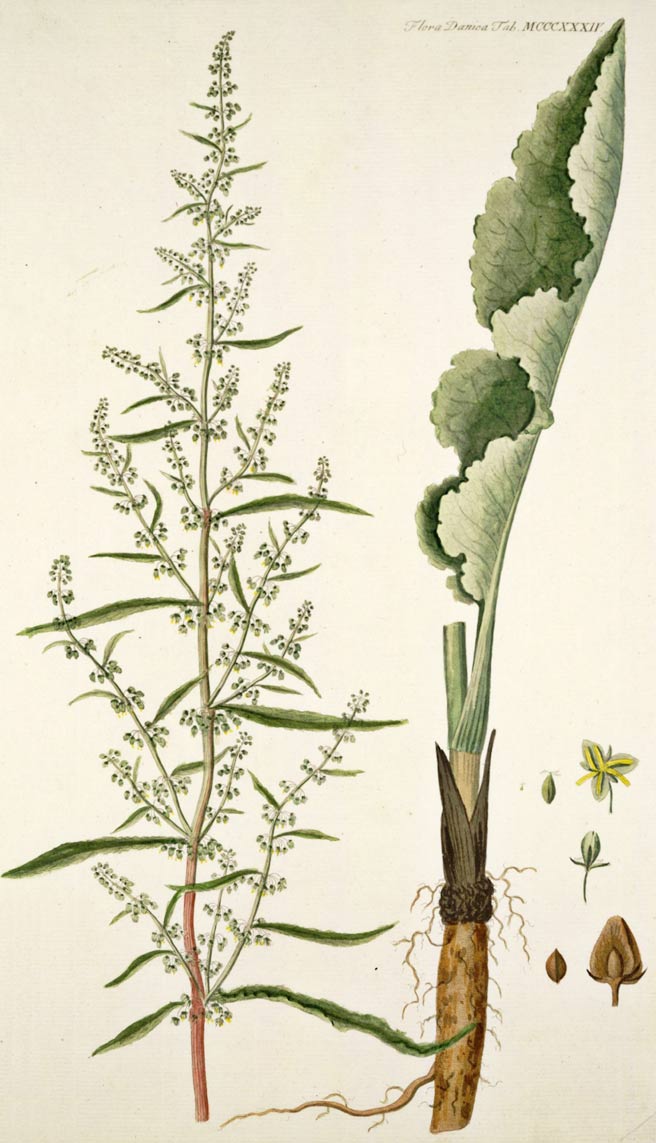 Also Known As:
Also Known As:
Broad-Leaved Dock, Curled Dock, Curly Dock, Field Sorrel, Yellowdock.
Scientific Name: Rumex crispus.
Family: Polygonaceae.
People Use This For:
Yellow dock is used for acute and chronic inflammation of nasal passages and the respiratory tract, as an adjunct to antibacterial therapy, a laxative, tonic.
Historically, yellow dock has been used for chronic skin diseases, dermatitis, rashes, scurvy, obstructive jaundice, and psoriasis with constipation.
Safety:
No concerns regarding safety. No reports of harm when used therapeutically.
Pregnancy and Lactation: Refer to a Medical Herbalist.
Effectiveness: There is insufficient scientific information available about the effectiveness of yellow dock.
Mechanism of Action: The applicable parts of yellow dock are the root and rhizome. Yellow dock contains anthraquinone glycosides, and tannins.56,57,58,59 Oxalate content is high in the leaves and low in the stalks.60 The anthroquinones (2-4%) have a mild stimulant laxative effect.56,58,59 Anthroid laxative use is not associated with an increased risk of developing colorectal adenoma or carcinoma.61 The tannins (12 20%)59,62 are responsible for the astringent effect.57 Yellow dock is reported to stimulate bile production.56 The leaves of yellow dock contain provitamin A (beta-carotene) and iron.62
Adverse Reactions: No reported problems with therapeutic amounts of root.
Interactions with Herbs & Supplements: No reported problems with therapeutic amounts of root.
Interactions with Drugs: No reported problems with therapeutic amounts of root.
Interactions with Foods: No reported problems with therapeutic amounts of root.
Interactions with Lab Tests: No reported problems with therapeutic amounts of root.
Interactions with Diseases or Conditions: No reported problems with therapeutic amounts of root.
Dosage/Administration:
Dr Clare’s Blends: 1gm per day
Oral: Typical dose of the dried root is 2-4 grams or as a tea.56 The liquid extract and a tincture 1-2 mL (1:5 in 45% alcohol) have also been used.56
Specific References: YELLOW DOCK
56. Newall CA, Anderson LA, Philpson JD. Herbal Medicine: A Guide for Healthcare Professionals. London, UK: The Pharmaceutical Press, 1996.
57. Foster S, Tyler VE. Tyler's Honest Herbal: A Sensible Guide to the Use of Herbs and Related Remedies. 3rd ed., Binghamton, NY: Haworth Herbal Press, 1993.
58. The Review of Natural Products by Facts and Comparisons. St. Louis, MO: Wolters Kluwer Co., 1999.
59. McGuffin M, Hobbs C, Upton R, Goldberg A, eds. American Herbal Products Association's Botanical Safety Handbook. Boca Raton, FL: CRC Press, LLC 1997.
60. Ellenhorn MJ, et al. Ellenhorn's Medical Toxicology: Diagnoses and Treatment of Human Poisoning. 2nd ed. Baltimore, MD: Williams & Wilkins, 1997.
61 Nusko G, Schneider B, Schneider I, et al. Anthranoid laxative use is not a risk factor for colorectal neoplasia: results of a prospective case control study. Gut 2000;46:651-5.
62. Brinker F. Herb Contraindications and Drug Interactions. 2nd ed. Sandy, OR: Eclectic Medical Publications, 1998.